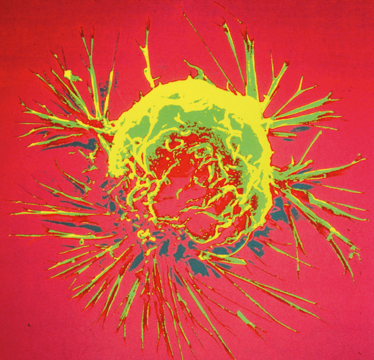Rac Attack
Could a protein that “cleans house” in breast tissue be harnessed to clear cancer cells?

Researchers have discovered an important role for the Rac1 protein in remodeling breast tissue (1) – and hope that the finding could prove valuable for cancer research.
When a woman becomes pregnant, dormant cells in the breast begin a process of growth and differentiation to provide milk. After a woman has stopped breastfeeding, the milk-producing machinery in the breast must be dismantled. The new study suggests that Rac1 plays an integral role not only in preparing the breasts for lactation, but in safely clearing away redundant tissue afterwards, by inducing breast epithelial cells to become phagocytic and engulf dying cells and surplus milk.
Without this housekeeping function, the apoptotic cells would be cleared via inflammatory processes, which could lead to tissue scarring and issues in producing milk during subsequent pregnancies. It’s this anti-inflammatory function that the researchers believe could be important in cancer.
“There’s compelling evidence that inflammation is linked to cancer, and tumor cells become necrotic, invoking inflammatory phagocytes. If healthy breast epithelia could be stimulated to remove the dying tumor cells it would keep the inflammatory phagocytes at bay; however, considerably more research is required first” says Nasreen Akhtar, first author, and Head of the Cell Polarity and Cancer Group at The University of Sheffield.
Aside from the potential for cancer therapy, there is much more to discover about mammary epithelia, as Akhtar explains, “The mammary gland is fascinating – it is one of the very few organs that develops postnatally, so by launching a pregnancy cycle you can uncover a goldmine of information about how cells grow, organize, differentiate, die, and are removed. And what we discover in the mammary gland is likely to teach us about the way other epithelial organs function.”
Akhtar and her team plan to continue investigating Rac1, as well as studying larger systems, “We are discovering the mechanisms by which our organs are shaped, using the mammary gland as a model system. Discovering how cells organize themselves within organs and how tissues are shaped is hugely important both for understanding cancer development and for organ replacement therapy, where one day we hope to grow our own organs in a tissue culture dish.”
- N Akhtar et al., “Rac1 controls both the secretory function of the mammary gland and its remodeling for successive gestations”, Dev Cell, 38, 522-535 (2016).
My fascination with science, gaming, and writing led to my studying biology at university, while simultaneously working as an online games journalist. After university, I travelled across Europe, working on a novel and developing a game, before finding my way to Texere. As Associate Editor, I’m evolving my loves of science and writing, while continuing to pursue my passion for gaming and creative writing in a personal capacity.















